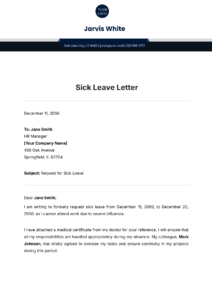The following sections delve into the practical aspects of implementing and utilizing such a system, exploring best practices for design, distribution, and management of these essential documents.
Key Components of a Leave Request Form
Effective leave management requires a standardized request process. Several key data points ensure clarity and facilitate efficient processing.
1. Employee Information: Accurate identification of the requesting employee, typically including full name, employee ID, department, and contact information.
2. Date of Request: The date the request is submitted helps track processing time and ensures accurate record-keeping.
3. Leave Period: Clearly specified start and end dates for the requested absence, including the total number of days requested.
4. Leave Type: Categorization of the leave, such as vacation, sick leave, personal time, or bereavement, allows for accurate tracking and reporting.
5. Reason for Leave (Optional): While not always mandatory, providing a brief explanation for the leave can be helpful for planning and approval considerations. Maintaining confidentiality for sensitive reasons is crucial.
6. Supervisor Approval: A designated space for supervisor signature or electronic approval signifies authorization of the leave.
Standardized data collection through these components ensures consistent record-keeping, simplifies leave management, and supports effective communication between employees and their supervisors. This facilitates accurate tracking of leave balances, efficient resource allocation, and compliance with company policies.
How to Create an Annual Leave Request Form
Developing a standardized form for leave requests promotes efficient absence management and ensures clear communication. The following steps outline best practices for creating such a document.
1: Determine Required Information: Essential fields include employee identification, dates of requested leave, type of leave, and supervisor approval. Additional fields, such as reason for leave, may be included based on organizational needs and legal requirements. Prioritizing data privacy for sensitive information is critical.
2: Choose a Format: Options include digital documents (e.g., word processors, spreadsheets), online forms, or dedicated HR software. Digital formats offer streamlined workflows and efficient storage. Accessibility across various devices should be considered.
3: Design a Clear Layout: Organize fields logically to ensure ease of use and completeness. Clear labels and instructions minimize ambiguity. Visual consistency with other company documents maintains professional branding.
4: Establish a Submission Process: Define how employees submit completed forms. This could include electronic submission, physical delivery, or integration with an HR management system. A clear process reduces confusion and ensures timely receipt.
5: Communicate the Policy: Ensure all employees are aware of the new form, how to access it, and how to complete and submit requests. Providing training or clear documentation aids smooth implementation.
6: Regular Review and Updates: Periodically review the form’s effectiveness and update as needed. Solicit feedback from employees and supervisors to identify areas for improvement and adapt to evolving organizational needs.
A well-designed, accessible, and clearly communicated leave request process improves efficiency, reduces administrative overhead, and fosters a transparent and organized approach to managing employee absences. Regular review and adaptation maintain relevance and efficacy.
Standardized leave request procedures, facilitated by well-designed templates, are indispensable for modern organizations. They ensure clarity, consistency, and efficiency in managing employee absences. From streamlined workflows and improved communication to accurate record-keeping and compliance with employment regulations, the benefits are substantial. A well-defined process, encompassing clear guidelines for creation, distribution, and completion of requests, empowers both employees and management to navigate leave administration effectively. This contributes to a more organized, productive, and positive work environment.
Effective absence management is not a static process. Regular review and adaptation of leave request procedures are crucial to accommodate evolving organizational needs and maintain best practices. This proactive approach ensures the continued effectiveness of these systems, supporting a dynamic and responsive work environment. Ultimately, a commitment to robust leave management processes contributes to a healthier, more balanced, and productive workforce.
